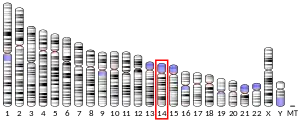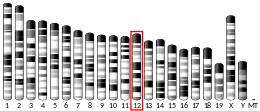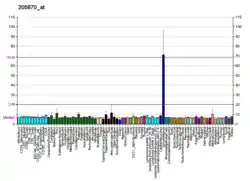Bradykinin receptor B2
Bradykinin receptor B2 is a G-protein coupled receptor for bradykinin, encoded by the BDKRB2 gene in humans.
Mechanism
The B2 receptor is a G protein-coupled receptor, probably coupled to Gq and Gi. Gq stimulates phospholipase C to increase intracellular free calcium and Gi inhibits adenylate cyclase. Furthermore, the receptor stimulates the mitogen-activated protein kinase pathways. It is ubiquitously and constitutively expressed in healthy tissues.
The B2 receptor forms a complex with angiotensin converting enzyme (ACE), and this is thought to play a role in cross-talk between the renin-angiotensin system (RAS) and the kinin-kallikrein system (KKS). The heptapeptide angiotensin (1-7) also potentiates bradykinin action on B2 receptors.[5]
Kallidin also signals through the B2 receptor. An antagonist for the receptor is Hoe 140 (icatibant).[6]
Function
The 9 amino acid bradykinin peptide elicits many responses including vasodilation, edema, smooth muscle spasm and pain fiber stimulation.
Gene
Alternate start codons result in two isoforms of the protein.[7]
See also
References
- GRCh38: Ensembl release 89: ENSG00000168398 - Ensembl, May 2017
- GRCm38: Ensembl release 89: ENSMUSG00000021070 - Ensembl, May 2017
- "Human PubMed Reference:". National Center for Biotechnology Information, U.S. National Library of Medicine.
- "Mouse PubMed Reference:". National Center for Biotechnology Information, U.S. National Library of Medicine.
- Fernandes L, Fortes ZB, Nigro D, Tostes RC, Santos RA, Catelli De Carvalho MH (2001). "Potentiation of bradykinin by angiotensin-(1-7) on arterioles of spontaneously hypertensive rats studied in vivo". Hypertension. 37 (2 Part 2): 703–9. doi:10.1161/01.hyp.37.2.703. PMID 11230360.
- Wirth K, Hock FJ, Albus U, Linz W, Alpermann HG, Anagnostopoulos H, Henk S, Breipohl G, König W, Knolle J (1991). "Hoe 140 a new potent and long acting bradykinin-antagonist: in vivo studies". Br. J. Pharmacol. 102 (3): 774–7. doi:10.1111/j.1476-5381.1991.tb12249.x. PMC 1917928. PMID 1364852.
- "Entrez Gene: BDKRB2 bradykinin receptor B2".
Further reading
- Duchêne J, Schanstra J, Cellier E, et al. (2002). "[30 years: Happy birthday, GPCR. The bradykinin B2 receptor: an alternative and antiproliferative pathway]". Néphrologie. 23 (1): 39–41. PMID 11908480.
- Ariza AC, Bobadilla NA, Halhali A (2007). "[Endothelin 1 and angiotensin II in preeeclampsia]". Rev. Invest. Clin. 59 (1): 48–56. PMID 17569300.
- Hess JF, Borkowski JA, Young GS, et al. (1992). "Cloning and pharmacological characterization of a human bradykinin (BK-2) receptor". Biochem. Biophys. Res. Commun. 184 (1): 260–8. doi:10.1016/0006-291X(92)91187-U. PMID 1314587.
- Eggerickx D, Raspe E, Bertrand D, et al. (1992). "Molecular cloning, functional expression and pharmacological characterization of a human bradykinin B2 receptor gene". Biochem. Biophys. Res. Commun. 187 (3): 1306–13. doi:10.1016/0006-291X(92)90445-Q. PMID 1329734.
- Kammerer S, Braun A, Arnold N, Roscher AA (1995). "The human bradykinin B2 receptor gene: full length cDNA, genomic organization and identification of the regulatory region". Biochem. Biophys. Res. Commun. 211 (1): 226–33. doi:10.1006/bbrc.1995.1800. PMID 7779089.
- Braun A, Kammerer S, Böhme E, et al. (1995). "Identification of polymorphic sites of the human bradykinin B2 receptor gene". Biochem. Biophys. Res. Commun. 211 (1): 234–40. doi:10.1006/bbrc.1995.1801. PMID 7779090.
- Ma JX, Wang DZ, Ward DC, et al. (1995). "Structure and chromosomal localization of the gene (BDKRB2) encoding human bradykinin B2 receptor". Genomics. 23 (2): 362–9. doi:10.1006/geno.1994.1512. PMID 7835885.
- Powell SJ, Slynn G, Thomas C, et al. (1993). "Human bradykinin B2 receptor: nucleotide sequence analysis and assignment to chromosome 14". Genomics. 15 (2): 435–8. doi:10.1006/geno.1993.1084. PMID 7916737.
- Menke JG, Borkowski JA, Bierilo KK, et al. (1994). "Expression cloning of a human B1 bradykinin receptor". J. Biol. Chem. 269 (34): 21583–6. PMID 8063797.
- Hess JF, Borkowski JA, Macneil T, et al. (1994). "Differential pharmacology of cloned human and mouse B2 bradykinin receptors". Mol. Pharmacol. 45 (1): 1–8. PMID 8302267.
- McIntyre P, Phillips E, Skidmore E, et al. (1993). "Cloned murine bradykinin receptor exhibits a mixed B1 and B2 pharmacological selectivity". Mol. Pharmacol. 44 (2): 346–55. PMID 8394991.
- AbdAlla S, Godovac-Zimmermann J, Braun A, et al. (1996). "Structure of the bradykinin B2 receptors' amino terminus". Biochemistry. 35 (23): 7514–9. doi:10.1021/bi9601060. PMID 8652530.
- Isami S, Kishikawa H, Araki E, et al. (1996). "Bradykinin enhances GLUT4 translocation through the increase of insulin receptor tyrosine kinase in primary adipocytes: evidence that bradykinin stimulates the insulin signalling pathway". Diabetologia. 39 (4): 412–20. doi:10.1007/BF00400672. PMID 8777990. S2CID 2243985.
- Dalemar LR, Ivy Jong YJ, Wilhelm B, Baenziger NL (1996). "Protein kinases A and C rapidly modulate expression of human lung fibroblast B2 bradykinin receptor affinity forms". Eur. J. Cell Biol. 69 (3): 236–44. PMID 8900488.
- Soskic V, Nyakatura E, Roos M, et al. (1999). "Correlations in palmitoylation and multiple phosphorylation of rat bradykinin B2 receptor in Chinese hamster ovary cells". J. Biol. Chem. 274 (13): 8539–45. doi:10.1074/jbc.274.13.8539. PMID 10085087.
- Cassano G, Susca F, Lippe C, Guanti G (1999). "Two B1 and B2 bradykinin receptor antagonists fail to inhibit the Ca2+ response elicited by bradykinin in human skin fibroblasts". Gen. Pharmacol. 32 (2): 239–44. doi:10.1016/S0306-3623(98)00275-4. PMID 10188626.
- Efremov R, Truong MJ, Darcissac EC, et al. (1999). "Human chemokine receptors CCR5, CCR3 and CCR2B share common polarity motif in the first extracellular loop with other human G-protein coupled receptors implications for HIV-1 coreceptor function". Eur. J. Biochem. 263 (3): 746–56. doi:10.1046/j.1432-1327.1999.00553.x. PMID 10469138.
- Marrero MB, Venema VJ, Ju H, et al. (1999). "Endothelial nitric oxide synthase interactions with G-protein-coupled receptors". Biochem. J. 343 (2): 335–40. doi:10.1042/0264-6021:3430335. PMC 1220558. PMID 10510297.
- Reyes-Cruz G, Vázquez-Prado J, Müller-Esterl W, Vaca L (2000). "Regulation of the human bradykinin B2 receptor expressed in sf21 insect cells: a possible role for tyrosine kinases". J. Cell. Biochem. 76 (4): 658–73. doi:10.1002/(SICI)1097-4644(20000315)76:4<658::AID-JCB14>3.0.CO;2-7. PMID 10653985.
- Golser R, Gorren AC, Leber A, et al. (2000). "Interaction of endothelial and neuronal nitric-oxide synthases with the bradykinin B2 receptor. Binding of an inhibitory peptide to the oxygenase domain blocks uncoupled NADPH oxidation". J. Biol. Chem. 275 (8): 5291–6. doi:10.1074/jbc.275.8.5291. PMID 10681501.
External links
- "Bradykinin Receptors: B2". IUPHAR Database of Receptors and Ion Channels. International Union of Basic and Clinical Pharmacology.
- Human BDKRB2 genome location and BDKRB2 gene details page in the UCSC Genome Browser.
This article incorporates text from the United States National Library of Medicine, which is in the public domain.




